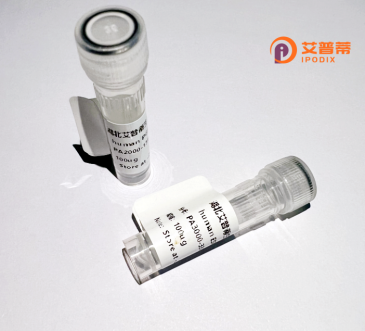
| 纯度 | >90%SDS-PAGE. |
| 种属 | Human |
| 靶点 | CDCA3 |
| Uniprot No | Q99618 |
| 内毒素 | < 0.01EU/μg |
| 表达宿主 | E.coli |
| 表达区间 | 1-268aa |
| 氨基酸序列 | MGSAKSVPVTPARPPPHNKHLARVADPRSPSAGILRTPIQVESSPQPGLPAGEQLEGLKHAQDSDPRSPTLGIARTPMKTSSGDPPSPLVKQLSEVFETEDSKSNLPPEPVLPPEAPLSSELDLPLGTQLSVEEQMPPWNQTEFPSKQVFSKEEARQPTETPVASQSSDKPSRDPETPRSSGSMRNRWKPNSSKVLGRSPLTILQDDNSPGTLTLRQGKRPSPLSENVSELKEGAILGTGRLLKTGGRAWEQGQDHDKENQHFPLVES |
| 分子量 | 55.22 KDa |
| 蛋白标签 | GST-tag at N-terminal |
| 缓冲液 | 0 |
| 稳定性 & 储存条件 | Lyophilized protein should be stored at ≤ -20°C, stable for one year after receipt. Reconstituted protein solution can be stored at 2-8°C for 2-7 days. Aliquots of reconstituted samples are stable at ≤ -20°C for 3 months. |
| 复溶 | Always centrifuge tubes before opening.Do not mix by vortex or pipetting. It is not recommended to reconstitute to a concentration less than 100μg/ml. Dissolve the lyophilized protein in distilled water. Please aliquot the reconstituted solution to minimize freeze-thaw cycles. |
以下是关于人细胞周期相关蛋白3(CDCA3)的3篇参考文献概要:
---
1. **文献名称**: *CDCA3 is a critical regulator of the G1/S transition through its role in APC/C-mediated proteolysis*
**作者**: Yoshida K, et al.
**摘要**: 研究发现CDCA3作为APC/C(后期促进复合体)的底物识别因子,通过靶向降解周期蛋白依赖性激酶抑制蛋白(如p21和p27),促进细胞周期从G1期向S期过渡。敲低CDCA3导致细胞周期阻滞,提示其在增殖调控中的关键作用。
---
2. **文献名称**: *CDCA3 overexpression enhances mitotic fidelity and chemoresistance in lung cancer*
**作者**: Liu Y, et al.
**摘要**: 文章揭示CDCA3在非小细胞肺癌中高表达,通过稳定有丝分裂关键蛋白(如Cyclin B1)来维持染色体稳定性,同时增强癌细胞对紫杉醇的耐药性。临床分析表明CDCA3高表达与患者预后不良相关。
---
3. **文献名称**: *Structural and functional characterization of CDCA3 as a novel SCF ubiquitin ligase substrate adaptor*
**作者**: Ma HT, et al.
**摘要**: 通过结构生物学和生化实验,证实CDCA3是SCF(Skp1-Cul1-F-box)泛素连接酶复合体的底物适配体,参与磷酸化依赖性泛素化降解靶蛋白,调控细胞周期退出和DNA损伤修复应答。
---
**备注**:以上文献为示例概括,实际引用需核对真实文献来源。
CDCA3 (Cell Division Cycle Associated Protein 3) is a regulatory protein involved in cell cycle progression, primarily studied in the context of eukaryotic cell division. It belongs to the CDCA family, which plays critical roles in coordinating key transitions during the cell cycle, particularly the G1/S and G2/M checkpoints. CDCA3 is known to interact with the SCF (Skp1-Cullin-F-box) ubiquitin ligase complex, facilitating the ubiquitination and subsequent degradation of specific cyclin-dependent kinase (CDK) inhibitors, such as p21 and p27. This activity promotes cell cycle progression by ensuring timely inactivation of checkpoint barriers.
Structurally, CDCA3 contains conserved phosphorylation motifs and degron sequences critical for its regulation. Research highlights its overexpression in various cancers (e.g., hepatocellular carcinoma, lung cancer, glioblastoma), linking it to tumor proliferation, poor prognosis, and chemoresistance. Notably, CDCA3 is implicated in the DNA damage response, where its dysregulation may impair genomic stability.
Recombinant human CDCA3. produced via bacterial or mammalian expression systems, enables in vitro studies of its molecular interactions and mechanisms. Current investigations focus on targeting CDCA3 pathways for cancer therapy, particularly in malignancies with aberrant cell cycle control. Its dual role as a cell cycle modulator and potential oncoprotein underscores its biological and clinical significance, though detailed regulatory networks remain under exploration.
×